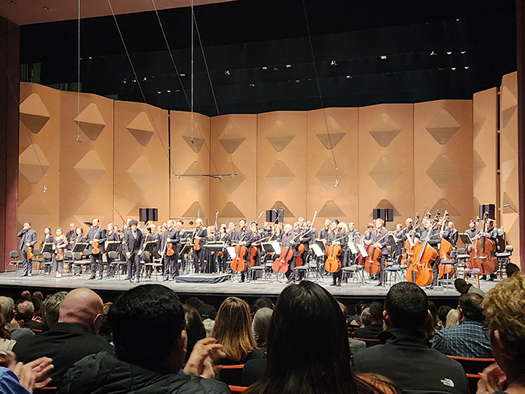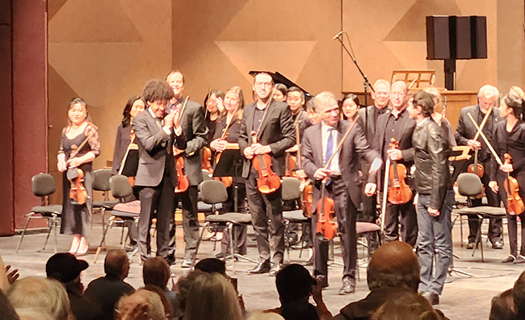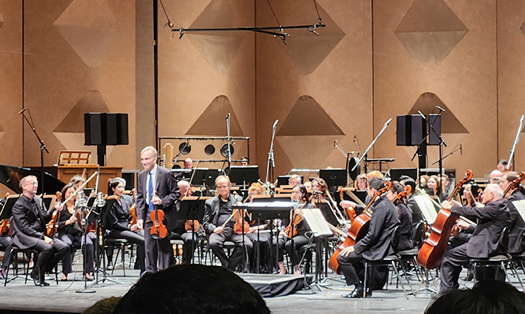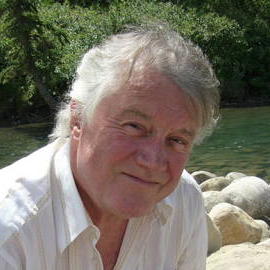 WORD SEARCH: Can you solve Allan Rae's classical music word search puzzles? We're currently publishing one per month.
WORD SEARCH: Can you solve Allan Rae's classical music word search puzzles? We're currently publishing one per month.
A Terrific Concert
RON BIERMAN listens to Gill Shaham and the San Diego Symphony Orchestra conducted by Rafael Payare
If this concert didn't convince newcomers to classical music that they'd been missing out, nothing will. Conductor Rafael Payare went all out for excitement and got it with a program that displayed the orchestra's virtuosity. The result was an exceptionally enjoyable performance.
Maurice Ravel's La Valse, one of many works written for George Balanchine's ballet company a century ago, was the opening salvo. Although many have called it a parody of the Viennese waltz or a depiction of the tragic situation in Vienna after the First World War, Ravel said it was neither, just 'an ascending progression of sonority, to which the stage comes along to add light and movement'.
His comment at the head of the score is more poetic, and surely closer to what many listeners visualize and feel. 'Through whirling clouds, waltzing couples may be faintly distinguished. The clouds gradually scatter ... The light of the chandeliers bursts forth ... in an imperial court ...'
Payare built from a mysterious beginning in the double basses to those whirling clouds in the higher strings and two harps. There was a moment near the beginning when the flow seemed to be lost as other instruments joined in, but then it was a well-judged progression to the main waltz. In Ravel's glorious orchestration its effect was one Strauss might have envied. A thunderclap bass-drum exclamation point ended the piece, and immediate vigorous applause followed.

Rafael Payare and the San Diego Symphony on 25 February 2024.
Photo © 2024 Ron Bierman
According to the Bachtrack music site, La Valse was the most often performed classical work in 2022. Mason Bates may well be the most frequently performed contemporary classical composer in 2024. He came to the stage to introduce his 'Nomad' violin concerto, which was co-commissioned by Nashville Symphony and San Diego Symphony. This was its Westcoast premiere. Bates looked more like a pop star in blue jeans and a short tight leather jacket as he took the stage for introductory comments. He told the audience that the inspiration for the 'Nomad' concerto came during a lunch with violinist Gil Shaham that included a discussion of the music of the Roma wanderers, or gypsies as they were often called in the twentieth century.

From left to right: Rafael Payare, Gil Shaham and Mason Bates with (behind) members of the San Diego Symphony on 25 February 2024.
Photo © 2024 Ron Bierman
The work is in four movements. The opening movement is 'Song of the Balloon Man', a musical description of an old balloon seller who sings what Bates describes as a 'doleful tune'. 'Magician at the Bazaar' follows, a short movement of shimmering mercurial beauty. The mood returns to softer reflection for 'Desert Vision: Oasis'. The closing 'Le jazz manouche' invokes the century-old rhythms and jazzy melodies produced by the collaboration of guitarist Django Reinhardt and violinist Stéphane Grappelli.
Whether doleful or jazzy, Gil Shaham's tone is as warmly expressive as that of any violinist on the planet, and Payare offered satisfying support.

Gil Shaham (standing) with members of the San Diego Symphony on 25 February 2024. Photo © 2024 Ron Bierman
Classical music took a wrong turn in the twentieth century when music schools began to over-emphasize how music is constructed at the cost of losing audiences. The tide has turned, and Bates is one of the modern composers who writes with a pleasing mix of intelligence and heart. This is his second violin concerto, and both have a good chance of entering the repertoire.
Sidenote. If you admire the 'gypsy' violin, try Roby Lakatos. Yehudi Menuhin was a fan. Lakatos shows off in this clip.
Listen — Hungarian violinist Roby Lakatos improvising:
Ottorino Respighi's Pines of Rome entered the repertoire shortly after it was composed one hundred years ago and has never left. Payare's performance showed why. Even the score's recorded bird calls were notably cheerful and enthusiastic. Before the closing fireworks of the fourth and final movement, the piece has many moments of solo pleasures. Several first chairs took advantage of the spotlight to show their considerable musical skills. Andrea Overturf's extended English horn solo was a warmly enchanting highlight.
But the evening's main highlight belonged to the brass section's thrilling power in the fourth and final movement of Respighi's tone poem. When Payare peered up over his shoulder to cue trumpets in the upper balcony, the audience turned to see what was happening. It was a memorable moment in the most exciting version I've ever heard of the work, live or recorded.
Ravel's Bolero closed the program. Its masterful melodic repetition either maddens or enthralls. In this performance the opening snare-drum rhythm was, as intended, barely audible, the volume increasing steadily as soloists repeat the main melody and its lone relative. Much of the effectiveness of the piece depends on how well the conductor manages the ever-increasing volume as different instruments and then sections appear. The final climax comes fifteen minutes after the quiet snare-drum entry.
The soloists again did their part, and the lush fullness of strings and gleaming brass were exhilarating. But the strength of the brass peaked a bit too soon. Already at the top, the crucial moment when a key change in the trumpets heralds a triumphant finish fell just short of its maximum impact. Nonetheless, it was a terrific concert and the latest proof of just how good the orchestra and its current conductor are.
Copyright © 4 March 2024
Ron Bierman,
San Diego, USA




